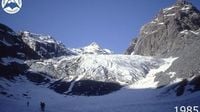Italy’s Ventina glacier, a once-mighty river of ice nestled in northern Lombardy, has reached a turning point that scientists and environmentalists hoped would never come. After 130 years of hands-on observation, geologists announced on August 18, 2025, that they can no longer measure the glacier in person. The culprit? Relentless climate change, which has melted the glacier so extensively that the very stakes once used to track its retreat are now buried beneath rockslides and debris, making the terrain too unstable for human access.
This dramatic shift, reported by the Lombardy Glaciological Service and covered by outlets such as the Associated Press, marks a sobering milestone in the story of Europe’s glaciers. The Ventina glacier, one of the largest in its region, has lost an astonishing 1.7 kilometers (about 1 mile) in length since the first measuring benchmarks were installed in 1895. Of that, 431 meters (471 yards) vanished in just the past decade—and nearly half of that loss occurred since 2021 alone. The pace of change is not just rapid; it’s accelerating.
“While we could still hope until the 1980s that there would be normal cycles or at least contained retraction, in the last 40 years something truly striking has occurred,” Andrea Toffaletti, a member of the Lombardy Glaciological Service, told reporters. His words reflect a sense of disbelief shared by many scientists who have watched the glacier’s slow but steady decline take a sharp turn for the worse in recent decades.
In the past, geologists would trek up to the glacier’s edge each year, driving stakes into the ice to mark its retreat. But this summer’s record-breaking heat—part of a broader trend of hotter, drier conditions—triggered rockslides and left the surface so unstable that in-person measurements are now impossible. Instead, the Lombardy Glaciological Service will turn to drone imagery and remote sensing technologies to monitor what’s left of the glacier. It’s a high-tech solution to a heartbreaking problem, and one that underscores just how much the landscape has changed.
According to the Lombardy Glaciological Service, the Alps have become a climate hotspot, warming at twice the global average rate since pre-industrial times. This trend has already led to the loss of more than 64% of the volume of Alpine glaciers—a figure that’s as startling as it is sobering. The Ventina glacier’s fate is not unique; it is part of a much larger pattern affecting glaciers throughout the Alps, Dolomites, and even the central Apennines.
Traditionally, glaciers melt a bit each summer, with the runoff feeding mountain streams and rivers. But the balance has shifted. “To regenerate and remain in balance, a certain amount of residual snow from the winter must remain on the glacier’s surface at the end of the summer. And this is happening less and less frequently,” Toffaletti explained. The combination of inadequate winter snowfall and blistering summer heat has undermined the very process that once allowed glaciers to persist through the ages.
The numbers tell a stark story. Since the late 19th century, the Ventina glacier has steadily shrunk, but the rate of loss has grown dramatically. In the last ten years alone, the glacier has retreated by 431 meters—almost half of that since 2021. It’s not just a local phenomenon, either. A study published in February 2025 in Nature found that the world’s glaciers lost ice at a rate of about 255 billion tons annually from 2000 to 2011. That number jumped to roughly 346 billion tons per year over the next decade, a clear sign that the problem is accelerating worldwide.
What does this mean for the region and beyond? The consequences are far-reaching. The loss of glaciers affects water supplies, as the summer meltwater that once fed rivers and streams becomes scarcer. Biodiversity takes a hit as habitats change or disappear. Local economies that depend on glacier-fed tourism and agriculture face new uncertainties. And, perhaps most troubling of all, the changes happening in places like Ventina are a preview of what’s to come elsewhere if global warming continues unchecked.
Italy’s glaciers, from the Alps and Dolomites in the north to the Apennines further south, have all been shrinking for years. The reasons are clear: not enough snow in the winter, and summers that seem to break new heat records every year. According to the Lombardy Glaciological Service, this combination has made it nearly impossible for glaciers to recover. The snowpack that once lingered through the summer now melts away too quickly, leaving the ice beneath exposed and vulnerable.
It’s not just scientists who are concerned. Local communities have watched as familiar landscapes transform before their eyes. The disappearance of glaciers threatens not only the region’s natural beauty but also its cultural heritage. For generations, the Ventina glacier has been a symbol of the Alps—a living, shifting monument to the power of nature. Its rapid decline is a stark reminder of how quickly things can change.
The story of the Ventina glacier is, in many ways, the story of climate change writ large. It’s a tale of slow beginnings and sudden accelerations, of traditions upended by forces beyond human control. And while the move to drones and remote sensing represents a technological leap, it also signals a retreat—a concession that the old ways no longer work in a world transformed by warming temperatures.
As Andrea Toffaletti put it, the changes of the last 40 years have been “truly striking.” The hope for normal cycles of retraction has given way to a new reality, one in which glaciers like Ventina may soon exist only in memory and in data gathered from afar. The urgency of the moment is clear: what’s happening in Lombardy is a warning, not just for Italy, but for the world.
With each passing year, the stakes—both literal and figurative—grow higher. The Ventina glacier’s story is a vivid illustration of the profound and accelerating impacts of climate change, and a call to action for those who would preserve what remains of our planet’s icy heritage.




